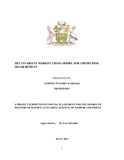| dc.description.abstract | The aim of the study is to use a multivariate Markov model to simulate the dynamics of
correlated credit ratings of multiple firms. Credibility theory is used to get the weighting used to
estimate the transition matrix and other unknown model parameters in the multivariate Markov
chain model. The study presents a higher-order Markov chain models for forecasting the various
credit risk rating dynamics. The results are transition matrices from various risk ratings.
The most important step in analyzing data is the selection of an appropriate mathematical model
for the data as it helps in predictions and hypothesis testing. The research design used for the
study was a descriptive research design that basically involves obtaining information concerning
the current status of the phenomena to describe, "What exists" with respect to variables or
conditions in a situation Gardner et al (2004). This design was appropriate for this study, as it
. gave the relevant information as it was.
The traditional reduced-form approach assumes that the losses from a credit risk at each
particular rating class can be evaluated based on accounting information and principles. With the
data entered and parameters estimated, a prediction table of transition probabilities from one
grade to another was created which indicated that the Ching et al (2002) model follows a 3rd
order polynomial to be able to come up with the transition matrices.
In conclusion the transition matrices were estimated by the use of a linear combination of the
empirical transition matrix and prior estimate of the transition matrix. By incorporating both the
historical rating data and another source of information about rating data which includes expert
opinion or subjective views, one is able to come up with the next period's rating of a particular
credit risk to that depends on its current rating and also the current ratings of other credit risks inthe portfolio. | en_US |

